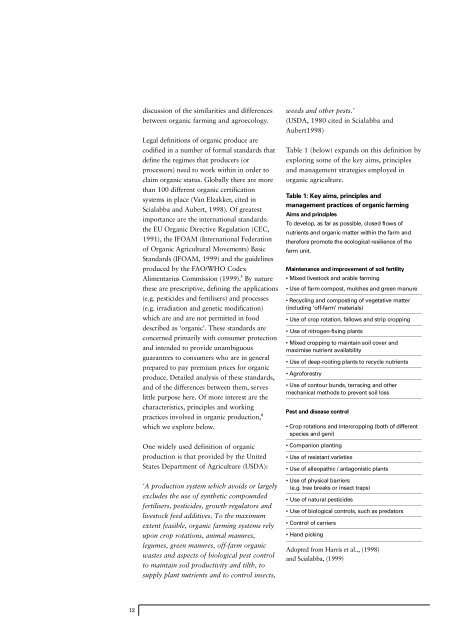The Real Green Revolution - Greenpeace UK
The Real Green Revolution - Greenpeace UK
The Real Green Revolution - Greenpeace UK
Create successful ePaper yourself
Turn your PDF publications into a flip-book with our unique Google optimized e-Paper software.
discussion of the similarities and differences<br />
between organic farming and agroecology.<br />
Legal definitions of organic produce are<br />
codified in a number of formal standards that<br />
define the regimes that producers (or<br />
p rocessors) need to work within in order to<br />
claim organic status. Globally there are more<br />
than 100 diff e rent organic cert i f i c a t i o n<br />
systems in place (Van Elzakker, cited in<br />
Scialabba and Aubert, 1998). Of gre a t e s t<br />
i m p o rtance are the international standard s :<br />
the EU Organic Directive Regulation (CEC,<br />
1991), the IFOAM (International Federation<br />
of Organic Agricultural Movements) Basic<br />
S t a n d a rds (IFOAM, 1999) and the guidelines<br />
p roduced by the FAO/WHO Codex<br />
Alimentarius Commission (1999). 1 By nature<br />
these are prescriptive, defining the applications<br />
(e.g. pesticides and fertilisers) and pro c e s s e s<br />
(e.g. irradiation and genetic modification)<br />
which are and are not permitted in food<br />
described as ‘organic’. <strong>The</strong>se standards are<br />
c o n c e rned primarily with consumer pro t e c t i o n<br />
and intended to provide unambiguous<br />
guarantees to consumers who are in general<br />
p re p a red to pay premium prices for org a n i c<br />
p roduce. Detailed analysis of these standard s ,<br />
and of the diff e rences between them, serv e s<br />
little purpose here. Of more interest are the<br />
characteristics, principles and working<br />
practices involved in organic pro d u c t i o n , 2<br />
which we explore below.<br />
One widely used definition of organic<br />
production is that provided by the United<br />
States Department of Agriculture (USDA):<br />
‘A production system which avoids or largely<br />
excludes the use of synthetic compounded<br />
fertilisers, pesticides, growth regulators and<br />
livestock feed additives. To the maximum<br />
extent feasible, organic farming systems rely<br />
upon crop rotations, animal manures,<br />
legumes, green manures, off-farm organic<br />
wastes and aspects of biological pest control<br />
to maintain soil productivity and tilth, to<br />
supply plant nutrients and to control insects,<br />
weeds and other pests.’<br />
(USDA, 1980 cited in Scialabba and<br />
Aubert1998)<br />
Table 1 (below) expands on this definition by<br />
exploring some of the key aims, principles<br />
and management strategies employed in<br />
organic agriculture.<br />
Table 1: Key aims, principles and<br />
management practices of organic farming<br />
Aims and principles<br />
To develop, as far as possible, closed flows of<br />
nutrients and organic matter within the farm and<br />
t h e re f o re promote the ecological resilience of the<br />
f a rm unit.<br />
Maintenance and improvement of soil fert i l i t y<br />
• Mixed livestock and arable farming<br />
• Use of farm compost, mulches and green manure<br />
• Recycling and composting of vegetative matter<br />
(including ‘off - f a rm’ materials)<br />
• Use of crop rotation, fallows and strip cro p p i n g<br />
• Use of nitrogen-fixing plants<br />
• Mixed cropping to maintain soil cover and<br />
maximise nutrient availability<br />
• Use of deep-rooting plants to recycle nutrients<br />
• Agro f o re s t ry<br />
• Use of contour bunds, terracing and other<br />
mechanical methods to prevent soil loss<br />
Pest and disease control<br />
• Crop rotations and interc ropping (both of diff e rent<br />
species and geni)<br />
• Companion planting<br />
• Use of resistant varieties<br />
• Use of alleopathic / antagonistic plants<br />
• Use of physical barriers<br />
(e.g. tree breaks or insect traps)<br />
• Use of natural pesticides<br />
• Use of biological controls, such as pre d a t o r s<br />
• C o n t rol of carr i e r s<br />
• Hand picking<br />
Adopted from Harris et al.., (1998)<br />
and Scialabba, (1999)<br />
12




![[2007] EWHC 311 - Greenpeace UK](https://img.yumpu.com/22079793/1/184x260/2007-ewhc-311-greenpeace-uk.jpg?quality=85)












